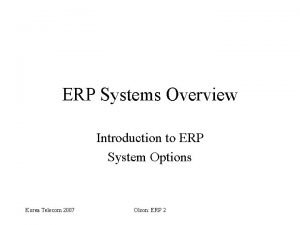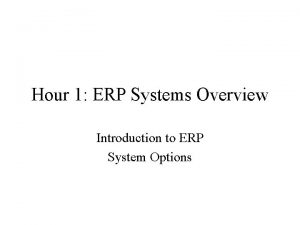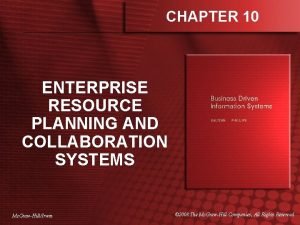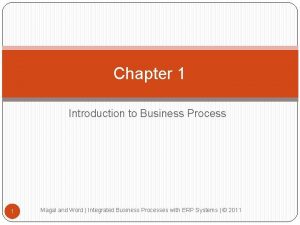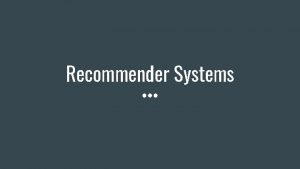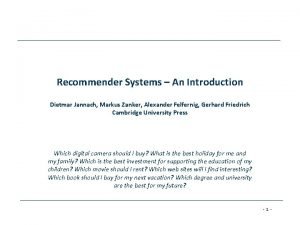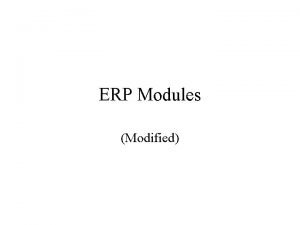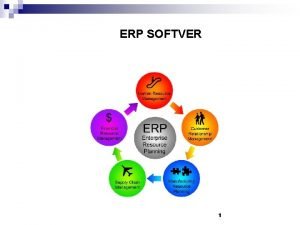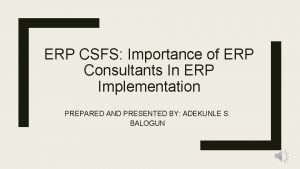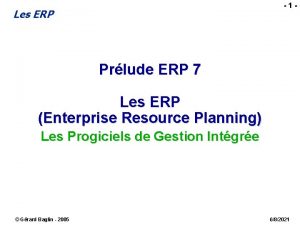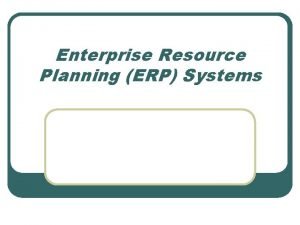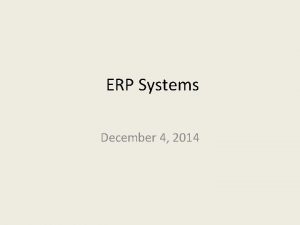Chapter 1 ERP Systems Introduction to ERP Modified







![SAP: Best Practices • A key to original product • Davenport [1998]: – Firm’s SAP: Best Practices • A key to original product • Davenport [1998]: – Firm’s](https://slidetodoc.com/presentation_image_h2/11089562a0119bf3be9adfb9abe2ea32/image-8.jpg)

![Benefits of ERP • Davenport [1998]: – Increases speed of information flows • O’Leary Benefits of ERP • Davenport [1998]: – Increases speed of information flows • O’Leary](https://slidetodoc.com/presentation_image_h2/11089562a0119bf3be9adfb9abe2ea32/image-10.jpg)
![Success case of ERP • Weil [1999]: – Applied Robotics increased on-time deliveries 40% Success case of ERP • Weil [1999]: – Applied Robotics increased on-time deliveries 40%](https://slidetodoc.com/presentation_image_h2/11089562a0119bf3be9adfb9abe2ea32/image-11.jpg)



- Slides: 14

Chapter 1: ERP Systems Introduction to ERP (Modified)

ERP Claims • Create value through integrating activities across organization • Implementation of best practices • Standardization of processes • One-source data • On-line access to information

Role in Business • ERP began with SAP in early 1970 s – Accounting basis – US products – some extension of MRP – Combine business computing • Unified system sharing one set of data • Advantages in efficiency, accuracy – Best Practices • Apply the best process for each function

Historical Growth • 1970 s & 1980 s – more development than growth • 1990 s – became widely adopted by large firms • Late 1990 s – growth exploded with fears of Y 2 K problems • Post-2000 – growth slowed – Saturated market, economy dipped – Seeking to • Fill in gaps with larger firms • Make products useful for smaller firms • Emphasize Internet

Why Study ERP? • Technical: – Integration of computer systems foster consistency, efficiency • Financial: – Integrating applications saves money • Organizational: – All members of organization use same system

Market for ERP • Over 100 vendors • BOPSE – BAAN – Oracle – People. Soft – SAP – JDEdwards Dutch database HRM originally German, pioneer of ERP emphasize Internet

SAP • Originally mainframe – SAP R/2 – 1974 • Client/Server architecture early 1990 s – More flexible – SAP R/3
![SAP Best Practices A key to original product Davenport 1998 Firms SAP: Best Practices • A key to original product • Davenport [1998]: – Firm’s](https://slidetodoc.com/presentation_image_h2/11089562a0119bf3be9adfb9abe2ea32/image-8.jpg)
SAP: Best Practices • A key to original product • Davenport [1998]: – Firm’s vary in what is best for them – Business world dynamic – Rigid approach has dangers – If a firm develops a competitive advantage, they give it up by adopting “best practices”

Table 2: ERP Supported Functions Financial Hum Res Ops & Log Sales & M Accts receivable Time accounting Inventory Orders Asset account Payroll MRP Pricing Cash forecast Personnel plan Plant Mtce Sales Mgt Cost accounting Travel expense Prod planning Sales plan Exec Info Sys Project Mgmt Financial consol Purchasing General ledger Quality Mgmt Profit analysis Shipping Standard costing Vendor eval
![Benefits of ERP Davenport 1998 Increases speed of information flows OLeary Benefits of ERP • Davenport [1998]: – Increases speed of information flows • O’Leary](https://slidetodoc.com/presentation_image_h2/11089562a0119bf3be9adfb9abe2ea32/image-10.jpg)
Benefits of ERP • Davenport [1998]: – Increases speed of information flows • O’Leary [2000]: – – Create value through integration of activities Best practices improve operations Standardization increases efficiency One-source data more accurate, easier to access • Better organizational planning • Better communication • More collaboration
![Success case of ERP Weil 1999 Applied Robotics increased ontime deliveries 40 Success case of ERP • Weil [1999]: – Applied Robotics increased on-time deliveries 40%](https://slidetodoc.com/presentation_image_h2/11089562a0119bf3be9adfb9abe2ea32/image-11.jpg)
Success case of ERP • Weil [1999]: – Applied Robotics increased on-time deliveries 40% through ERP – Delta Electronics reduced production control labor requirements 65%

Advantages & Disadvantages • System Integration – Improved understanding across users – Less flexibility • Data Integration – Greater accuracy – Harder to correct • Better methods – More efficiency – Less freedom & creativity • Expected lower costs – More efficient system planned – Dynamic needs, training typically underbudgeted, hidden implementation costs

Conception vs. Reality • Integrated System • In fact, vendors usually sell modules – Would like to sell full system – Buyers reduce cost, risk, by starting smaller scale • Risk of converting entire system • Complex cost impact

Summary • ERP software has had a major impact on organizational computing • Technological, financial, organizational benefits • Also expensive, massive, inflexible • Many hidden costs • Complex system meriting study
 Erp system overview
Erp system overview Erp system options and selection methods
Erp system options and selection methods Core and extended erp components
Core and extended erp components Chapter 3 lesson 1 introduction to global systems
Chapter 3 lesson 1 introduction to global systems Ems system components
Ems system components Introduction of business process
Introduction of business process Introduction of tally
Introduction of tally Decision support systems and intelligent systems
Decision support systems and intelligent systems Engineering elegant systems: theory of systems engineering
Engineering elegant systems: theory of systems engineering Embedded systems vs cyber physical systems
Embedded systems vs cyber physical systems Elegant systems
Elegant systems Introduction of system analysis and design
Introduction of system analysis and design Introduction to recommender systems
Introduction to recommender systems Recommender systems an introduction
Recommender systems an introduction Dual mode in os
Dual mode in os
